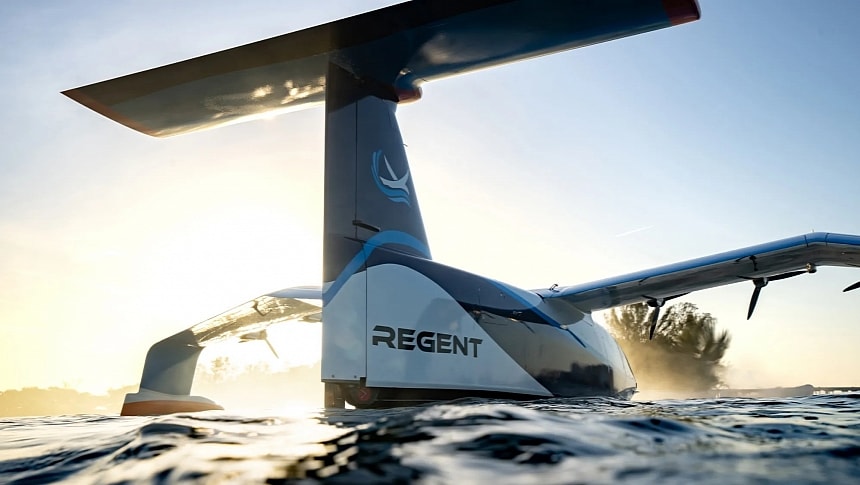A new strategic partnership is expanding Regent's world domination. Japanese heavy-hitters have seen this innovative technology's potential for efficient, zero-emission travel, and they want a piece of it. Soon enough, Regent seagliders will provide clean, fast passenger transportation across Japan's coastal areas and beyond.
The Rhode Island-based Regent has managed to sell hundreds of seagliders to operators all over the world. This month, a strategic investment will bring this futuristic aircraft/boat to passengers in Japan. The name behind it is MOL (Mitsui O.S.K Lines), a shipping giant that was often featured here on autoevolution for its connection to innovative, green vessels.
The actual investment came from MOL's US-based venture capital firm, MOL Switch, and it will open the door to seaglider transportation in Japan and other coastal areas. This recent investment is only a confirmation of the growing interest in Japan for seaglider technology in general and Regent's vehicle in particular. The American company boasts an impressive lineup of strategic investors from Japan, including logistics giant YamatoHoldings and Japan Airlines (through the JapanAirlines Innovation Fund).
Japan is one of the island nations looking to implement efficient, sustainable means of transportation for all its citizens living in or near coastal areas. The Regent seaglider's main advantage is the all-electric propulsion, making it an emission-free alternative without compromising performance.
The company's flagship is named Viceroy. Viceroy sports a 12-seat configuration, a cruising speed of 180 mph (290 kph), and the ability to cover 180 miles (290 km) on a single charge. In the near future, Viceroy will be followed by Monarch, a beefed-up seaglider combining a 100-seat layout with a 500-mile (804 km) range.
One of the main secrets behind this innovative vehicle is hydrofoil technology. The e-seaglider is designed to take off from the dock like a boat and take flight once it reaches open water. During the initial phase, the seaglider rises on its hydrofoil; then, the vehicle retracts its foil and starts operating like an airplane. In flight mode, it remains close to the water (within one wingspan over the water).
The Regent e-seaglider basically boasts three operating modes: boat, hydrofoil, and aircraft. It's entirely electric, and it features both digital flight software and conventional boat controls. One of the main advantages of this hybrid structure is the compatibility with existing dock infrastructure, which translates to fewer costs and a faster transition to regular commercial service. Plus, the seaglider is fast enough to ensure time-efficient transportation and deliveries without adding to the local pollution.
So far, the Rhode Island-based company has secured orders worth more than $9 billion for over 600 units. Regent's global customers range from multiple ferry operators in Europe to Hawaii's Mokulele Airlines. The Viceroy flagship is expected to enter commercial service as soon as next year.
The actual investment came from MOL's US-based venture capital firm, MOL Switch, and it will open the door to seaglider transportation in Japan and other coastal areas. This recent investment is only a confirmation of the growing interest in Japan for seaglider technology in general and Regent's vehicle in particular. The American company boasts an impressive lineup of strategic investors from Japan, including logistics giant YamatoHoldings and Japan Airlines (through the JapanAirlines Innovation Fund).
Japan is one of the island nations looking to implement efficient, sustainable means of transportation for all its citizens living in or near coastal areas. The Regent seaglider's main advantage is the all-electric propulsion, making it an emission-free alternative without compromising performance.
The company's flagship is named Viceroy. Viceroy sports a 12-seat configuration, a cruising speed of 180 mph (290 kph), and the ability to cover 180 miles (290 km) on a single charge. In the near future, Viceroy will be followed by Monarch, a beefed-up seaglider combining a 100-seat layout with a 500-mile (804 km) range.
One of the main secrets behind this innovative vehicle is hydrofoil technology. The e-seaglider is designed to take off from the dock like a boat and take flight once it reaches open water. During the initial phase, the seaglider rises on its hydrofoil; then, the vehicle retracts its foil and starts operating like an airplane. In flight mode, it remains close to the water (within one wingspan over the water).
The Regent e-seaglider basically boasts three operating modes: boat, hydrofoil, and aircraft. It's entirely electric, and it features both digital flight software and conventional boat controls. One of the main advantages of this hybrid structure is the compatibility with existing dock infrastructure, which translates to fewer costs and a faster transition to regular commercial service. Plus, the seaglider is fast enough to ensure time-efficient transportation and deliveries without adding to the local pollution.
So far, the Rhode Island-based company has secured orders worth more than $9 billion for over 600 units. Regent's global customers range from multiple ferry operators in Europe to Hawaii's Mokulele Airlines. The Viceroy flagship is expected to enter commercial service as soon as next year.








